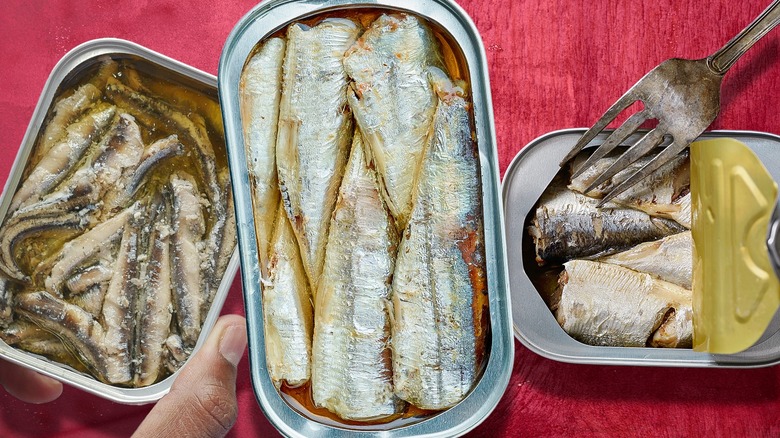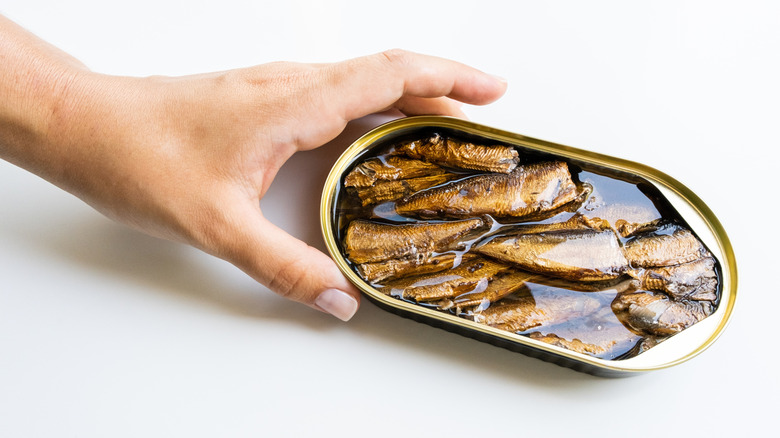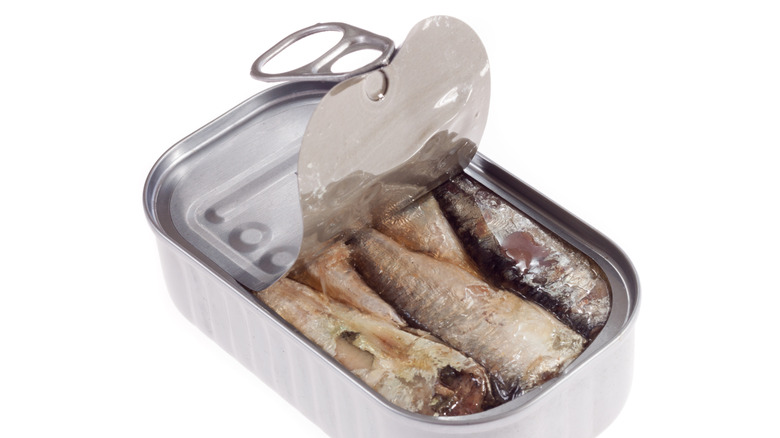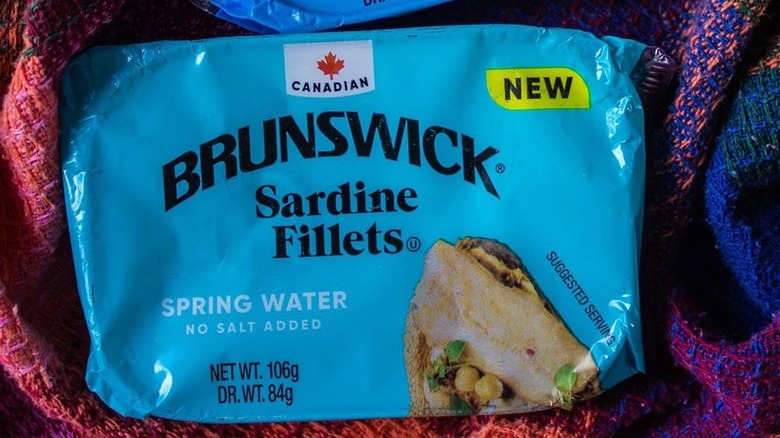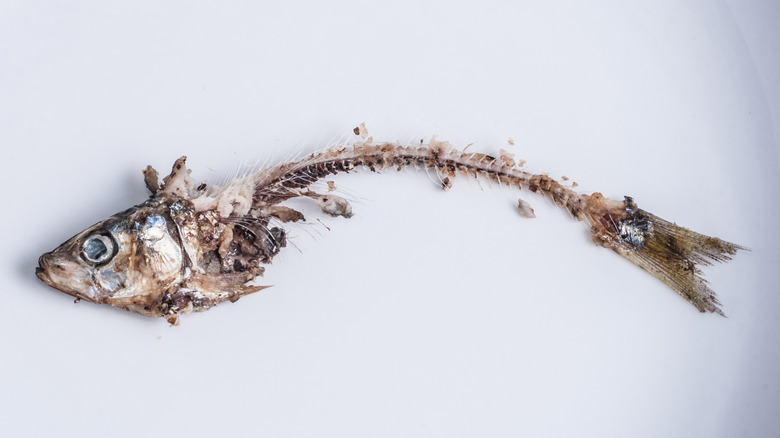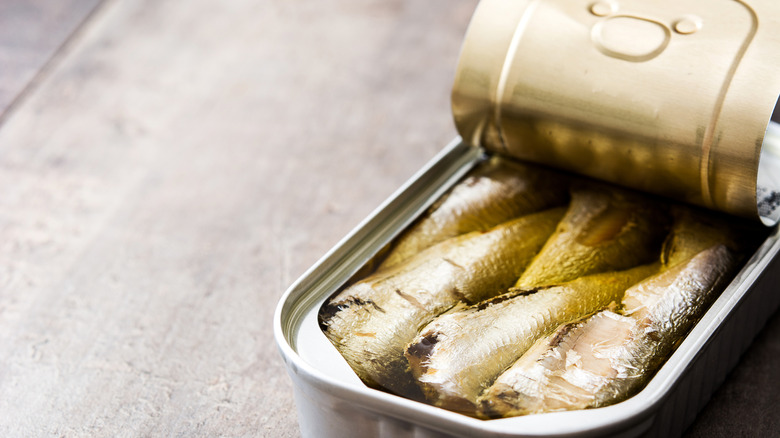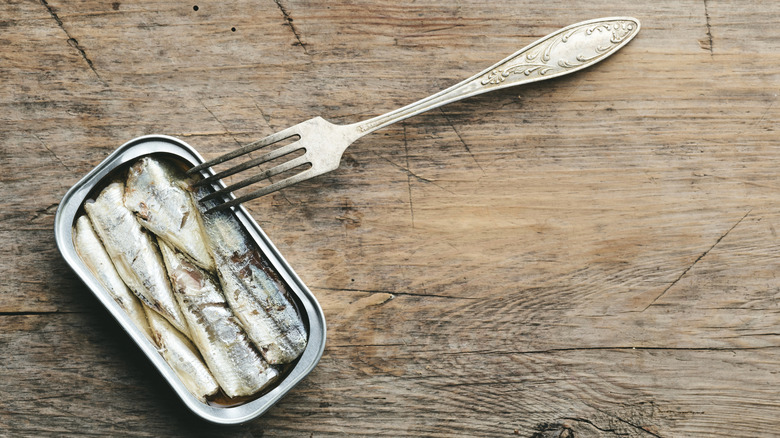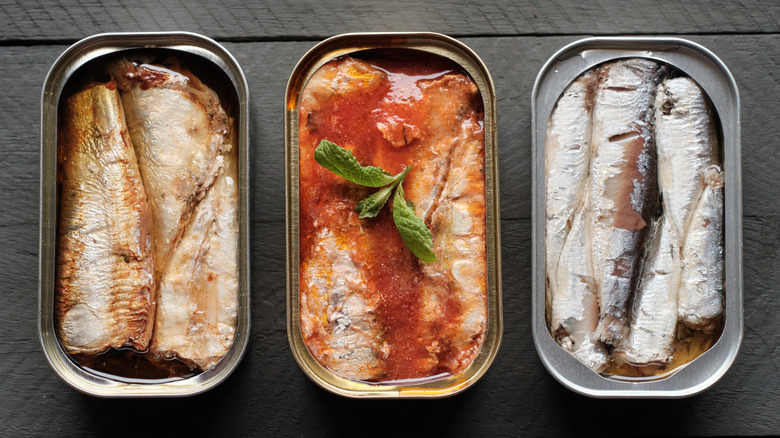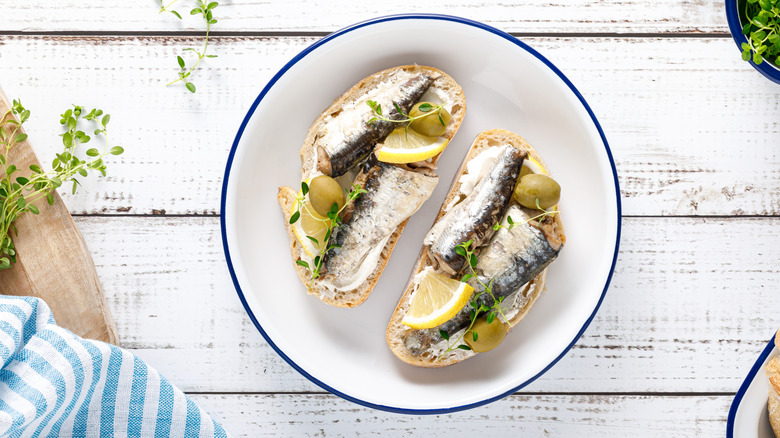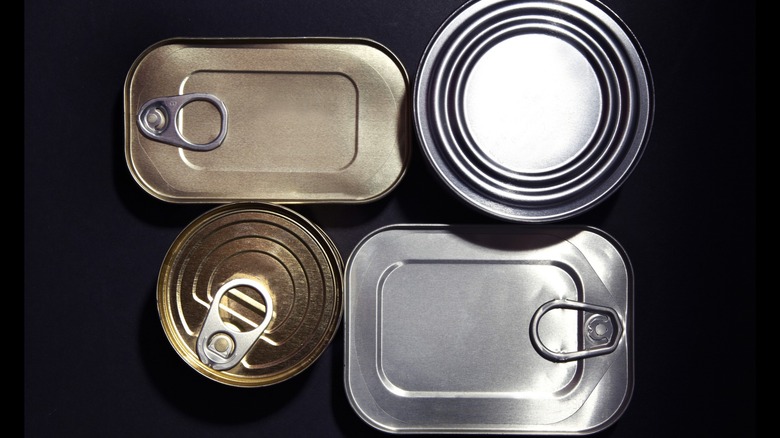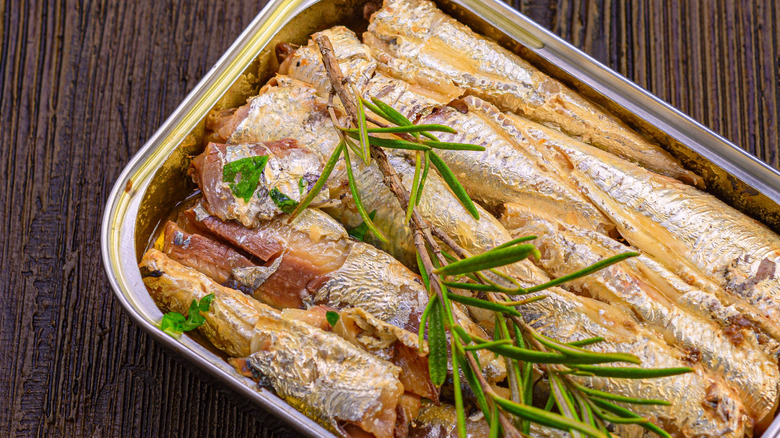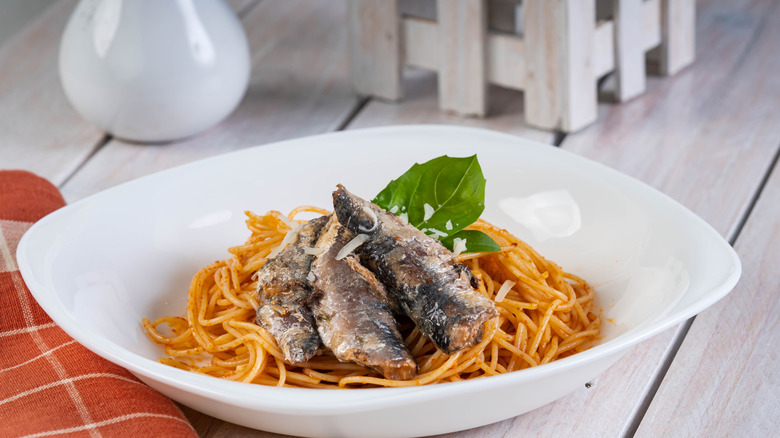15 Mistakes You're Making When Using Canned Sardines
If you're often unsure of what to serve when lunch or dinner rolls around, a can of sardines is a great jumping-off point. The tiny fish are packed with protein, vitamins, calcium, iron, omega-3 fatty acids, and other good-for-you nutrients. Add some veggies and a grain and it's easy to have dinner on the table with minimal effort. Not to mention, you can simply stockpile a bunch of cans to keep on hand whenever you're stuck without a menu.
That said, while canned sardines offer a simple solution to your mealtime woes, they can also pose some problems. What do you do with the excess oil? Do you really need to surgically extract the teeny bones from each individual fillet? Is the only way to serve the fish on a slice of toast? Are all sardines created equal or is there some merit to pricier products? We've broken down the most common issues and mistakes people make with canned sardines, to ensure you avoid them with your next tin.
1. Pouring out all the oil into the sink
Your first instinct might be to pour out the oil used to submerge the small sardine fillets, however, you'd be doing yourself a culinary disservice. Granted, you probably won't want to transfer it to a jar to keep on your countertop, but the flavor-packed oil is an easy way to enhance a wide range of dishes. For optimal taste and quality, stick to products canned with extra virgin olive oil.
Considering the fish content, you'll want to use the extra oil in dishes that can handle a bit of fishiness. Serve a leafy green salad alongside your canned sardines and use the oil in the vinaigrette. Plus, combining it with vinegar or lemon juice tames the fishiness, leaving you with a particularly flavorful dressing coating the leaves.
If you're adding the sardines to a pasta or rice dish, try sautéing chopped onions and garlic with the oil, to infuse them with even more flavor. Meanwhile, white fish can be enhanced with a quick marinade, which is the perfect place to use up that extra oil.
2. Purchasing low quality products
You often get what you pay for, which is partly true regarding canned sardines. We're not suggesting you need to spend $40 on a can to be satisfied. A quarter of that is pretty much the most you'd want to shell out unless your budget and gourmet inclinations suggest otherwise. Really, though, if you have the time and motivation, it's not a bad idea to taste-test your way through a few different canned sardine brands at varying price levels to see for yourself.
Although personal taste might result in a preference for a cheaper product over a more expensive one, purchasing mid-range sardines is worth it. A slightly higher price tag often means more attention to ingredients and processing. Canning is a preservation method, and if it isn't optimally done, it can decrease the taste and texture of a product. Canned sardines come pre-cooked, but there are various ways to do this, both manually and industrially. Much like most processed food, smaller-scale production tends to retain more quality, offering a taste of the nuances of sardines from a particular region.
Additionally, cheaping out on seafood often extends to the environmental sustainability of fishing and processing. Companies might save a few bucks by skipping out on regulations, but if they don't prioritize ecological methods, you might want to think twice about consuming their products and supporting their business.
3. Choosing unsustainable seafood
On that note, sustainable seafood is a hot topic directly related to canned sardines. What's the good in adding the tasty morsels to your diet if your consumption is inadvertently causing harm to the environment? While it might seem like an arduous task to sort out the good from the bad and keep track of fluctuations, thankfully, there are certifications to regulate sustainability. The Marine Stewardship Council (MSC) identifies select sardine populations based on their relative sustainability.
Products that get the stamp of approval have a blue MSC logo on the packaging, whereas those that aren't up to standard don't. Sustainable sardine fishing requires assessing local fish populations as they increase and decrease, to make decisions to maintain balance within an ecosystem. This relates to the quantity of fish in supply, as well as to the general preservation of their habitat. All of these factors are important to address to ensure that fish can continue to be a source of food for years to come.
4. Only buying sardines packed in water
If you're particularly conscious about the fat content in your diet, you might naturally lean toward canned sardines packed in water. And if you're doing so for health reasons and aren't in a position to budge, that's fine. However, if your motivations are vague and you think it's just the better choice, consider picking up a can of sardines packed in extra virgin olive oil and comparing the two.
Whereas water highlights the taste of the sardines with zero extras, olive oil enhances the richness and mouthfeel of the fatty fish. As the sardines sit in the can, they soak up the olive oil, resulting in an improved texture and taste over time. Once you pair them with a crunchy slice of toast or crackers, the contrast is all the more delicious.
Sure you'll be adding a little bit of fat to your meal, but the extra flavor from the olive oil will boost the taste substantially. While you could just eat water-packed sardines straight from the tin, buying oil-packed fish is a quicker way to noticeably boost the flavor, especially if you're planning to add olive oil or other ingredients to garnish.
5. Thinking you need to debone them
If you're uninitiated to canned sardines, you might be surprised to open up the tin and find spiny fish fillets with their heads still on. Unlike larger fish that have hard bones and spines, sardines are very small and these components are less noticeable. You can even eat them as long as you don't mind the slight textural element. Since the fillets are already cooked, the bones have time to soften. You'll barely notice them as you chew and swallow the sardines. Even better, they provide nutritional benefits thanks to the calcium and vitamin D content.
If you're still hesitant, removing the bones is often a simple process once you pull out the spine. Or, consider seeking out products packaged as deboned sardines to reduce the effort of extracting dozens of tiny bones. Similarly, the skin shouldn't be an issue as it is very thin and blends in with the meat, but if you're uncertain about consuming it, just find a can that contains skinless sardines.
6. Leaving the can open for too long
Canned food might have an enviably long shelf life when it's still sealed, but once you pop the tin open, the clock starts ticking. This is especially relevant when you're talking about canned fish like sardines. For starters, you'll want to transfer any extra sardines into an airtight container, since the tin can no longer be resealed. If you aren't planning on consuming the remainder within a few days, you can freeze the sardines for a few months, though their texture will be compromised in the process.
As it turns out, a 2022 study published in Foods determined that the optimal duration of freshness varies depending on what the fillets are soaking in. Sardines canned in water or oil typically start to drop in quality after being open for one day, whereas those preserved in tomato sauce have a shelf-life of around three days. The researchers concluded that regardless of the contents, sardines were inedible after one week, which isn't that surprising considering fish tend to start deteriorating after a few days.
7. Cooking them to a mush
Part of the appeal of canned sardines is the fact that they're already cooked. You can pop the can open and add them to any dish without having to cook them further. Of course, you may want to combine them with warm ingredients, in which case heating them will improve the overall culinary experience. That said, there's a fine line between reheating pre-cooked sardines and overheating them until they turn into mush.
If you're adding sardines to a stir-fry, pasta dish, or stew, toss them in near the end of the cooking process to prevent them from breaking down too much. On the other hand, if you want to heat them while adding a little bit of crispiness, transfer the sardines to a sheet pan and broil them in the oven. Meanwhile, if you want to maintain their firmness but serve them slightly warm, simply heat water in a saucepan and submerge the tin for a few minutes before opening it.
8. Only eating them straight from the can
Even though eating sardines by the forkful from the can is a quick and easy way to get a nutritious bite, it's bound to get boring sooner or later. Thankfully, there are plenty of uses for canned sardines and the pre-cooked fillets make a great addition to a wide range of recipes, from summer salads to hearty casserole bakes.
Serve them on toast or with crackers and a smear of butter to highlight their rich and briny flavor. For an easy protein boost packed with heart-healthy omega-3 fats, dump a can into a leafy green salad with your favorite crunchy vegetables. Meanwhile, you can add the tiny fish to pasta sauces, stir-fries, rice dishes, fish cakes, casseroles, pizza, and more. Mash them up with yogurt to make sardine pate, or mix them with sharp mustard or mayo to make an easy spread for toast. Sardines and eggs are another popular duo that's sure to provide you with a substantial amount of protein to start your day.
9. Avoiding them because of the fishiness
Sardines might have a fishy odor, but let's get it straight, they are fish. Although you might not want that fishiness lingering around your kitchen for days (be sure to be mindful when discarding the tin), a certain level of fishy qualities is expected. Of course, you can play it down by pairing tinned sardines with the right ingredients.
There's a reason lemon is such a common accompaniment for fish; the tangy acidity and citrus notes complement the briny and fatty fillets. If you're adding sardines to pasta or salad, make sure your sauce or dressing has a generous amount of lemon juice to balance the fishiness. You could even soak the fillets in a lemon juice mixture for several minutes to infuse them with more acidity.
Tomatoes are another high-acid ingredient that works well with sardines. Whether you buy sardines in tomato sauce or add the fillets to a tomato-based sauce or stew, it will tame the flavor if you're working your way up to embracing sardines in all their fishiness. Fresh herbs add another dimension to the dish too, bringing a freshness to brighten anything from sardines on toast to Sicilian pasta con le sarde.
10. Thinking all canned sardines taste the same
The quality of canned sardines varies greatly and depends on how the fish are caught, processed, cooked, and preserved. However, another relevant factor is their source; sardines from different locations will taste distinct due to their habitats and diets. The size of the fillets varies accordingly, as does their fat content, resulting in a range of tenderness.
As well, regions with strong canning traditions are likely to produce superior tinned fish, thanks to years of experience perfecting their techniques. Countries like Spain, Portugal, and France are known for their meaty sardines from the Atlantic coast, often preserved in local extra virgin olive oil. The Mediterranean Sea is home to sardines too, as are the Pacific and Indian Oceans surrounding Australia, North and South America, Japan, and South Africa. Meanwhile, Eastern Canada packs tasty fillets from the cool waters of the Atlantic, while Scandinavian countries commonly smoke the fish before canning.
11. Rinsing canned sardines
We've already pointed out that sardines packed in oil offer a more interesting flavor than those canned in water, and that you should be saving the oil in question. With that in mind, it makes sense that it's a mistake to rinse your can of sardines with water. Ultimately, you're just washing precious flavor down the drain. Water and oil aren't a great match, which means you might end up with sardines that have a questionable texture. Not to mention, if the water pressure is a little too high, you might end up obliterating the delicate fish under the flow.
Some people choose to reduce the salt and fat content by rinsing their can of sardines, but there are better alternatives. For example, you could choose sardines packed in water and drizzle olive oil over the top as needed, so you have control over how much you add. As for the salt, although canned foods tend to be higher in sodium, as long as you adjust your seasonings accordingly, it's all just extra flavor that will bring your dish together, which means less work on your end.
12. Pairing them with the wrong flavors
Sardines have a pretty strong umami character, along with fishy notes that require careful balance for milder palates. They can be a little pungent and in-your-face, though thankfully there is a wide variety of styles, origins, and flavor profiles to choose from. Once you have settled on a region and brand, pairing the small fish with the right ingredients is key.
While sardines can be incorporated into many dishes, if you want to highlight their qualities, your best bet is to match them with ingredients that offer acidity and freshness. A squeeze of lemon juice or a sprinkle of zest is a natural pairing, and one that is easy to do if you're low on time. The burst of acidity counters the fattiness of the fish, bringing them together in a savory bite. Similarly, pickled ingredients like onions or cabbage add a tang of acidity that is sure to complement the richness of the fish.
Meanwhile, fresh herbs, like cilantro and parsley, are a great way to elevate canned sardines. They add texture and flavor and can be served as garnish or whisked into a vinaigrette. For added texture, look no further than cucumber, which brings a subtle flavor and watery goodness that contrasts with the oily fish.
13. Assuming canned fish lasts forever
Canning is a surefire way to keep food shelf-stable and fresh over time, but there are limits when it comes to how long it can sit unopened. Different food products have different regulations regarding dating the labels with a best-by or use-by date, but you'll typically find one or the other on canned foods. When it comes to high-acid items like tomato sauce, the date is usually within 12 to 18 months, whereas other canned foods often list a date two to five years in the future. This means that if your sardines were canned in water or oil, they'll last longer than if they are canned with tomatoes or lemon juice.
Meanwhile, storage conditions can also affect the longevity of your canned sardines. If they're kept somewhere warm, they'll lose freshness faster than if they are kept in a cool location. Keep that in mind if your tinned fish sits close to a heater, near the oven, or in an area that overheats in the summer. The best way to avoid consuming sardines in suboptimal condition is to make sure to rotate your supply.
14. Missing out on their nutritious benefits
If you skip over canned sardines for fear of the unknown, you're missing out on some serious health benefits. The fatty fish is incredibly nutritious and one of the best options you can find in the canned fish aisle. Unlike larger fish like tuna, sardines are low in mercury, which makes them a suitable choice for most people to regularly consume. Just be mindful with seasoning if you are being cautious about your sodium intake.
Although their fat content might scare off some people (about 8.5 grams per 5 ounces), it is mostly heart-healthy omega-3 fatty acids, which have many pros. These fats are commonly correlated with having a positive relationship to heart health, thanks to their anti-inflammatory properties. They also may aid in brain health and cognition, which is undoubtedly a selling point. Meanwhile, the fish's tiny edible bones are packed with calcium, which can help strengthen bone density.
15. Serving them at the wrong temperature
Sardines are pretty versatile, since you can serve them as simply as straight from the can on a piece of toast or cook them in a casserole or pasta sauce. However, to fully enjoy their character, it's important not to serve them too cold or too warm. At room temperature, the aromas can shine through in all of their complexity. This is especially important if you're buying quality sardines and want to taste the nuances of the different types of sardines.
Granted, you probably won't store an unopened tin in the fridge, but be mindful of removing any leftovers from the fridge about 20 minutes before serving. Sardines packed in oil will especially benefit from the time to warm up, as the oil will congeal at cold temperatures.
On the flip side, overheating sardines in a dish leaves them mushy and lacking in distinct flavor, instead veering into fishy territory. Avoid this fate by adding them close to the end of the cooking time. Meanwhile, if you want to slightly heat your room-temperature sardines, a minute or two under the broiler will do the trick.
